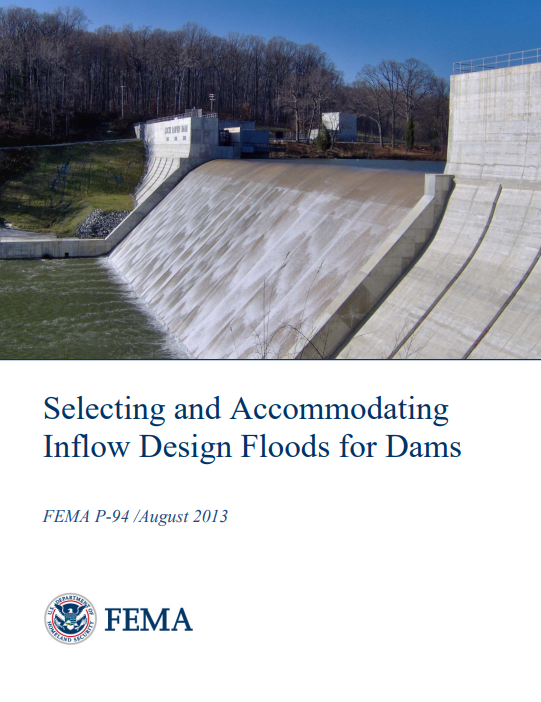National Dam Safety Program: Guidelines, Flyers and Other Tools
On this page:
Federal Guidelines for Dam Safety

Federal Guidelines for Dam Safety (FEMA P-93)
These guidelines apply to dam safety management practices for all federal agencies responsible for the planning, emergency preparedness, design, construction, operation, regulation of dams, and response to dam incidents (2023).

Glossary of Terms (FEMA 148)
Searchable Database -The purpose of FEMA P-148 is to establish a common Glossary of Terms for Dam Safety for use within and among federal agencies. The objective is to select terms that are generic and generally applicable to all dams, regardless of size, owner, or location.

Hazard Potential Classification System for Dams (FEMA 333)
Guidelines that set forth a hazard potential classification system for dams that is simple, clear, concise and adaptable to any agency's current system (2004).

Earthquake Analyses & Dam Design (FEMA 65)
Guidelines that provide the basic framework for the earthquake design and evaluation of dams (2005).

Selecting and Accommodating Inflow Design Floods for Dams (FEMA 94)
Guidelines that provide procedures for selecting and accommodating inflow design floods (2013).

Emergency Action Planning for Dams (FEMA 64)
Guidelines to encourage strict safety standards in the practices and procedures employed by federal agencies or required of dam owners regulated by the federal agencies. Guidelines to encourage emergency action planning for dams to help save lives and reduce property damage (2013).

Inundation Mapping of Flood Risks Associated with Dam Incidents and Failures (FEMA P-946)
The purpose of this document is to provide dam safety professionals with guidance on how to prepare dam breach inundation modeling studies and conduct mapping that can be used for multiple purposes, including dam safety, hazard mitigation, consequence evaluation and emergency management including developing EAPs. This guidance is intended to provide a consistent approach that can be applied across the country (2013).

Federal Guideline's for Dam Safety Risk Management (FEMA P-1025)
Guidelines for implementing risk-informed decision making in a dam safety program (2015).
Technical Manuals, Flyers, and Tools

FEMA Fact Sheet on Emergency Action Planning

FEMA Fact Sheet on Emergency Operations Plans

FEMA Fact Sheet on Risk Communications

Technical Manual: Conduits through Embankment Dams (FEMA 484)
Procedures and guidance for best practices associated with conduits through embankment dams (2005).

Technical Manual: Plastic Pipe Used in Embankment Dams (FEMA 675)
Procedures and guidance for best practices associated with embankment dams (2007).

Technical Manual: Impacts of Animals on Earthen Dams (FEMA 473)
A manual that provides guidance to dam specialists (2005).

Technical Manual: Impacts of Plants on Earthen Dams(FEMA 534)
A manual that advances awareness of dam safety problems associated with impacts on earthen dams (2005).

Technical Manual: Outlet Works Energy Dissipators (FEMA P-679)
This manual will focus on the methods by which energy resulting from the release ofwater through the outlet works is dissipated for safe discharge downstream(2010).

Risk Prioritization Tool for Dams (FEMA P-713)
The Risk Prioritization Tool for Dams is a standards-based decision-making tool for risk-based dam safety prioritization to be used by state dam safety regulators throughout the country to identify those dams within a large inventory that most urgently need attention and then allocate resources accordingly. Once priorities are judged, risk acceptance or tolerability is a matter of policy that will vary from state to state (2008).
Risk Prioritization Tool User Manual
Risk Prioritization Tool Risk Portfolio
Risk Prioritization Tool Template

Technical Manual: Overtopping Protection for Dams (FEMA P-1015)
The National Dam Safety Program sponsored the development of a technical manual, in conjunction with the Bureau of Reclamation, to collect and disseminate useful and relevant information regarding the design, construction, and performance of overtopping protection alternatives for embankment and concrete dams (2014).

Emergency Operations Planning: Dam Incident Planning Guide
This Dam Incident Planning Guide supports state, local, tribal, and territorial emergency managersinplanning for dam incidentsand failuresby summarizing the concepts that a community should considerwhen creating dam incident-specific elements of local emergency operations plans. Thisguide builds onComprehensive Preparedness Guide (CPG) 101:Developing and Maintaining Emergency Operations Plans.1It also provides guidance for dam owners and operators on how to engage with emergencymanagers prior to an incident to ensure a well-coordinated response. Appendix A provides a general template for acommunitydam incident plan that can be adapted to meet each community’s needs (2019).

Pocket Safety Guide for Dams and Impoundments (FEMA P-911)
This guide was developed as a quick reference to help dam owners and others assess low hazard dams and impoundments (2016).

Filters for Embankment Dams - Best Practices for Design and Construction
This document provides procedures and guidance for best practices concerning embankment dam filter design and construction and represents an effort to collect and disseminate current information and experience having a technical consensus (2011).

Evaluation and Monitoring of Seepage and Internal Erosion. (FEMA P-1032)
This document presents a summary of current Federal practices for monitoring and measuring seepage, identifying potential failure modes (PFMs) related to internal erosion, assessing risk related to internal erosion, and remediating internal erosion. While research continues into these processes, this document attempts to present the best understanding based on current Federal agency practice (2015).

Geotextiles in Embankment Dams, FEMA P-730
(2008)

Assessing the Consequences of Dam Failures. A How-To Guide
The Federal Emergency Management Agency (FEMA) developed Assessing the Consequences of Dam Failure: A How-To Guide to provide community officials and interested stakeholders with a process for assessing the potential economic, social, and environmental impacts of dam failure. (2012)

Selecting Analytic Tools for Concrete Dams to Address Key Events Along Potential Failure Mode Paths (FEMA P-1016)
The purpose of this document is to stress the importance of understanding the sequences of events leading to failure of concrete dams and selecting analysis methods that address these specific events. The selected analysis method may range from straightforward to complex, depending on the potential failure mode being analyzed. It is stressed that a less complex analysis with less uncertainty is the preferred strategy. Included in this report and the appendices are examples of this process. These examples are not intended to be a complete listing of concrete dam potential failure modes. Each dam is unique and has its own issues; therefore, it is important for the engineer to understand the potential failure modes and sequences of events that enable them(2014).

Summary of Existing Guidelines for Hydrologic Safety of Dams (FEMA P-919)
The overriding purpose of this report is to document the available data and to present the state of the practice for evaluating the hydrologic safety of dams, including inventorying current practices used by state and federal agencies. This work included a review of hydrologic guidelines currently used in each state and federal agency that regulates dams, and was guided by an independent steering committee and reviewed by the Research Work Group. A subsequent publication will include new federal guidelines for the evaluation of the hydrologic safety of dams that could be applied nationwide(2012).

Emergency Action Planning for State Regulated High-Hazard Potential Dams (FEMA 608)
Preventing loss of life from dam failure is the paramount concern of the National Dam Safety Program. This concern has intensified as a result of recent disasters that have focused attention on the state of the critical infrastructure in the United States and raised questions on the safety of dams nationwide. As part of a recent initiative to promote the implementation of Emergency Action Plans at all high-hazard potential dams across the United States, FEMA has asked all of the states to adopt the applicable recommendations contained in this paper (2007).

Dam Safety Warning Signs Best Practices -Promoting Public Awareness and Preventing Loss of Life (FEMA P-2188)
These best practices outline the process for identifying the need for safety signage, designing and implementing the signs and continually monitoring and assessing their effectiveness. This document encourages the use of proven and researched safety signage practices from industry leaders to promote stronger public safety practices around dams and reduce the loss of life. While readers are encouraged to contact the authority responsible for the dam, in the absence of any standards, this document can be used by any dam owner, operator, regulatory agency or member of the general public who is interested in increasing public safety around dams through the use of safety signage.
Program Guidance
Model State Dam Safety Program Manual (FEMA 316)
The overall purpose of the Model State Dam Safety Program (Model Program) is to enhance national dam safety. The objective is to encourage progressive safety standards in the promulgated practices and procedures state agencies use to regulate dam site investigation, design, construction, operation and maintenance, and emergency planning and preparedness. The Model Program is meant to outline the key components of an effective state dam safety program. It does not mirror any state program, nor does it supplant any state's existing criteria. It is intended to provide guidance on the development of more effective and sustainable state programs that will mitigate major risks facing dams across the nation. The Model Program is a collaborative effort between the Association of State Dam Safety Officials (ASDSO) and the Federal Emergency Management Agency (FEMA) National Dam Safety Program. The Model Program supports ASDSO’s mission to improve the condition and safety of dams through education, support state dam safety programs, and foster a unified dam safety community. (2022)

Dam Owner's Guidance Manual (FEMA 145)
This older reference contains still relevant guidance to owners to assist with setting up a sound dam safety program. Note: many states have updated this manual for use by owners that they regulate. Go to the US Map and click on the state or states of interest to view their manuals and policies (1987).


































